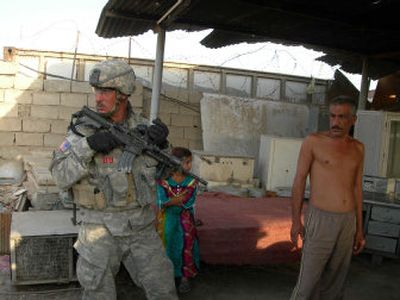Iraq combat tour extended

WASHINGTON – In the latest sign of pressure on troop strength from violence in Iraq, the Pentagon said Monday it has extended the combat tour of 4,000 U.S. Army soldiers, the second time in as many months that an Army brigade has seen its yearlong deployment lengthened.
The 1st Brigade of the 1st Armored Division, which is assigned to Ramadi, the capital of volatile al-Anbar province, will remain in Iraq an additional 46 days, defense officials said.
Originally scheduled to leave Iraq in January 2007, the brigade is now due to return to its home base in Germany in late February.
Coming after this summer’s announcement that an Alaska-based brigade would have its tour prolonged, analysts said the extension of the 1st Brigade’s assignment was the latest sign that the U.S. military is having a difficult time sustaining the current force level in Iraq of about 145,000 troops.
The 1st Brigade oversees military operations in Ramadi, where Sunni Arab insurgents opposed to the Shiite-dominated central government have waged a steady series of roadside bombings and other guerrilla-style attacks against both U.S. and Iraqi security forces. Since the summer, the 1st Brigade, which also has other Army and U.S. Marine Corps units attached to it, has been trying to pacify the area by establishing combat outposts.
Also on Monday, the Pentagon announced it would speed up the scheduled deployment of another brigade to relieve the 172nd Stryker Brigade, the Alaska unit. The 4th Brigade of the 1st Cavalry Division, originally scheduled to deploy in late October, will now leave for Iraq 30 days earlier. The 4th Brigade, based at Fort Bliss, Texas, will take the place of the 172nd.
On July 27, Defense Secretary Donald H. Rumsfeld approved a request by commanders to extend the tour of the 172nd, even as members of the unit had begun returning home. The four-month extension would have kept the Stryker brigade in Iraq until mid-December, prompting protests from families and relatives. The new schedule will bring the Alaska soldiers home by Thanksgiving.
“There’s no question but that anytime there’s a war, the forces of the countries involved are asked to do a great deal,” Rumsfeld said Monday in response to questions about the latest extension. “From time to time there may be units that will be asked to increase the number of days in-country from what had been anticipated. On the other hand, we’re also bringing you some other units in earlier, which is another way of dealing with that issue.”
But Army officials said they are worried about the amount of time combat-bound units have to train before deploying to Iraq. A primary reason for the 1st Armored Division brigade’s extension was to give the Army unit taking its place, the 1st Brigade of the 3rd Infantry Division, more time to prepare for deployment, its third combat tour.
“We’ve never sent a unit over there not prepared,” said an Army official. “The 1st Brigade of the 3rd Infantry Division needs more time.”
The 3rd Infantry Division’s 1st Brigade returned home to Fort Stewart, Ga., at the beginning of this year and would have been in the United States for only 11 months before returning to Iraq.
“Having a full year at home is very important for families,” the Army official said.
Ideally, the Army prefers to have a unit deployed overseas one year out of every three. Because of the demands of Iraq and Afghanistan, the Army is averaging about 14 months at home for active-duty brigades. But units have more to do in those short months as they train new soldiers joining the unit, acquire skills for the changing fight and learn to use new equipment.
Michelle Joyner, a spokeswoman for the National Military Families Association, said short times home between rotations to Iraq and extensions of combat tours were difficult for families.
“The time home is getting shorter and shorter and it is not like it used to be,” Joyner said. “It is 12-hour shifts and constant preparation. They are home, but they are not home.”
Extensions are familiar to Iraq veterans of the 1st Armored Division. In 2004, in an effort to tamp down the rising insurgency, division, during its first Iraq tour, had its yearlong deployment extended by 90 days.
Lawrence J. Korb, a senior adviser for the Center for Defense Information, said unless the government removes caps on the Army’s use of National Guard units in Iraq, future extensions are likely.
“The fact that you have to extend people says that you don’t have any more ready to replace them,” Korb said. “We don’t have enough troops because we had not planned to keep this many this long.”